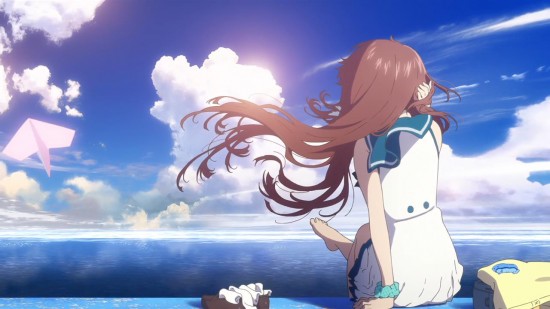
The usual warning applies: if you haven’t watched Nagi no Asukara (Crunchyroll) and you have any possible interest in watching it then you should watch it before reading the rest of this post.
If you have watched it and payed close attention and are pretty familiar with Japanese culture and folklore then you may not find anything new in this post. The show is actually more generous with explanations than the average Japanese fantasy. However not everyone got all the key points, so you may find this helpful.
Folklore Reference: The Little Mermaid
I won’t bother retelling this. I presume all of my English-speaking readers are familiar with either the original story by Hans Cristian Andersen or the Disney version. Which version doesn’t matter because NagiAsu doesn’t try to follow the original story exactly–but much of the first half of the series is devoted to the story of a mermaid who falls in love with a land-dweller. In the course of the story she must deal with the opposition of her father and a powerful magic-wielder.

(You may object to calling her a “mermaid” since she doesn’t have a tail, but I think the “sea people” of this story count as merfolk by any reasonable definition.)
Folklore Reference: The Dragon King
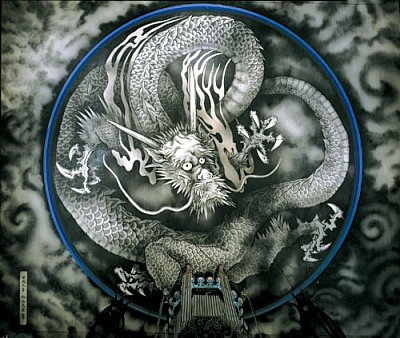 Perhaps more important are the numerous tales about Ryuujin, the dragon king of the sea. He is probably of Chinese origin. The name “Ryujin” is Sino-Japanese and the idea of dragons as water-spirits came from China. Nevertheless by the time the Japanese adopted Chinese characters and started writing down their myths he was already firmly ensconced in their folklore.
Perhaps more important are the numerous tales about Ryuujin, the dragon king of the sea. He is probably of Chinese origin. The name “Ryujin” is Sino-Japanese and the idea of dragons as water-spirits came from China. Nevertheless by the time the Japanese adopted Chinese characters and started writing down their myths he was already firmly ensconced in their folklore.
Ryuujin is a dragon, but he can assume human form. He lives under the sea in a magnificent palace with anthropomorphic sea creatures for servants. He sometimes invites humans to visit and he can be a generous host.
While in his palace humans can eat, drink, dance, sing and otherwise enjoy themselves as comfortably as if they were on land.
 Some tales concern his daughter Otohime (also called Toyotama-hime.) This dragon-princess married into the Japanese imperial family. Before she returned to the sea she gave birth to a son who became the father of the first emperor.
Some tales concern his daughter Otohime (also called Toyotama-hime.) This dragon-princess married into the Japanese imperial family. Before she returned to the sea she gave birth to a son who became the father of the first emperor.
In a much later story she fell in love with a fisherman named Tarou Urashima who had been invited to her father’s palace. He lived happily with her for many years but eventually he begged leave to return to his native village to visit his parents and friends. She consented and gave him a box, tied shut with a ribbon, which she told him never to open.
When he got home Tarou found it unrecognizable. 300 years had passed and everyone he knew was not only dead but forgotten. In despair he opened the box, which turned out to contain his accumulated years. Instantly he became centuries old and collapsed into a pile of dust.
Perhaps in opening the box he failed a test. If he had loved Otohime enough he would have obeyed her instructions, kept the box closed and returned to her.
The Founding Myth
There is a myth that everyone in the story universe knows–and since this is a fairy tale the myth is actually true.
First there is the Sea God. He can appear in mostly-human form (with scales) but we eventually learn that his true form is a dragon. Some of the land people have come to doubt his existence but the sea people have too much evidence in their daily lives to doubt that he is real.
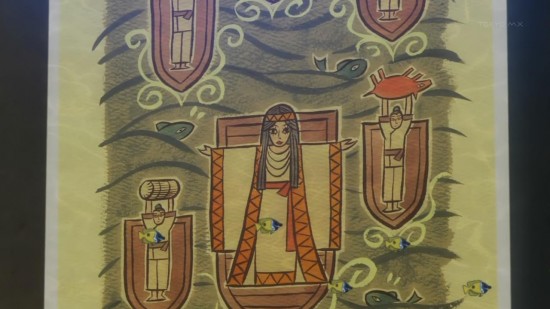
Humans originated under the sea but eventually migrated to the land. Angry at this abandonment, the Sea God started to create natural disasters. A young woman, remembered only by the title “Ojoshi-sama”, offered herself as a sacrifice to him. The Sea God married her and their children became the sea people.
Everyone knows that part of the story but it has a sad ending that only the adult sea people know. They don’t tell their children or the land people. Ojoshi left a boyfriend on the land and she pined for him. Eventually the Sea God decided to send her back to the land, but he took something from her first. When she returned to the land Ojoshi learned that her boyfriend was long dead.
What the Sea God took from her was the ability to fall in love. He feared that otherwise she would kill herself when she learned the truth.
The Nature of Ena
A central conceit of this story is “ena,” a transparent substance that coats the sea people like a second skin. This allows them to live under water, doing just about anything that a normal person can do on land. They can also function on land as long as they douse themselves with sea water several times a day. (This seems like a small price to pay for such a wonderful ability.)
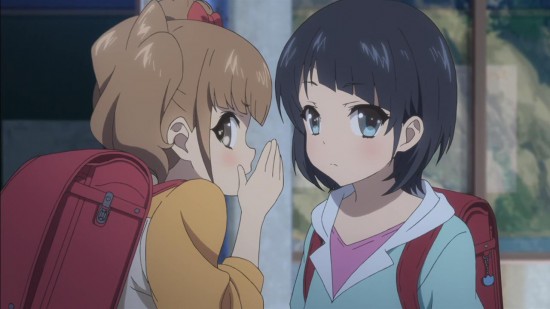
Sea people can mate with land people, but any children will be born without ena. Except for their eyes they will be indistinguishable from land people. (Sea people have bright blue eyes while the eyes of mixed-race children are a muddier shade of blue.)
Ena, it turns out, is actually made of love. More technically, it is made up of “detritus,” microscopic particles that float in the sea, carrying with them the loving feelings of all the people who have lived in the sea.
References to Real-World Problems
The story starts with the closing of the sea village’s middle school, which forces the remaining students to go to school on land. School closings, which can be traumatic for the affected students, sometimes happen in America due to demographic shifts. Japan’s declining population makes them much more common there and references to them in anime are also common.
In the last year or so a number of anime series have used “global cooling” as a metaphor for global warming. The world of Nagi no Asukara is suffering from a long-term cooling trend which will eventually make the land uninhabitable–though not for many generations.
The reason for this is never given. Maybe the land people have been messing up the environment. In any case, it’s not the Sea God’s fault. He has no power over the land.
The Ofunehiki
Since time immemorial the sea people and the land people have jointly conducted a yearly ceremony called the “Ofunehiki” or “Boatdrift Ceremony” in which they commemorate Ojoshi’s sacrifice by offering a wooden maiden to the Sea God. The dramatic pageantry serves to remind the two peoples of their common heritage.
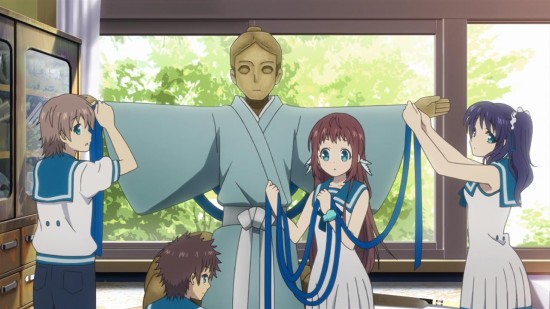
But now the land people, suffering economic hard times and increasing resentful of the sea people, announce that they no longer want to do the ceremony. Then the weather starts getting bad…
So this looks like a typical Shinto parable about how we need to stay in harmony with nature and ancient ceremonies honoring the natural gods are an appropriate and necessary way to do this. It certainly seems that way to the main characters, who work to try to get the two sides to agree to restart the ceremony. Once they do that the Sea God will be satisfied and everything will be fine, right?
Actually no, because things are much more complicated than that.
Sensing that the traditional ceremony may not be enough, some of the female characters either offer themselves as a living sacrifice, or at least consider doing so. Fortunately this is not the sort of horror story where something like that is the answer.
The Sea God’s grief over losing Ojoshi was so unendurable that he dissolved. A small part of him became Uroko-sama, determined to protect the sea people by whatever means necessary.
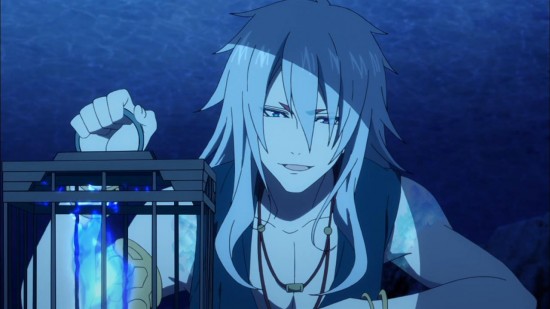
The rest of the Sea God continued to exist, but not as a conscious rational being. He was more like a super-powerful id, full of inchoate longing for Ojoshi to return.
The wooden offering of the Ofunehiki served to calm the waves for a while, but it was never a real answer to the problem.
The Crisis
As long as most of the sea people remained in the sea, Uroko-sama was satisfied. Even if the land froze over, the Sea God’s power was sufficient to keep the sea from freezing, so the sea people would survive.
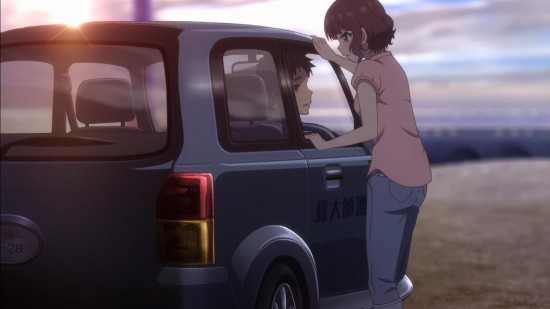
The crisis seemed to start with Akari’s marriage to a land-dweller but that wasn’t the real problem. A few sea people had left the sea to marry land people in the past. As long as the number was small this was tolerable.
The real problem was the closing of the middle school. If all the sea kids had to go to school on land they would form attachments on land. Given the greater choice of potential mates, most would marry land people. Their children would not have ena so their descendents would die with the land. Uroko-sama faced the total extinction of the sea people, and this he could not allow.
So he allowed the sea to cool and forced the sea people to go into hibernation. He did not say how long it would last, but clearly his intention was that they should hibernate until all the land people were dead, eliminating the threat they posed.
The Resolution
The resolution of the story depends on two key discoveries. The first is Miuna’s discovery that, though half-breeds are born without ena, if they plunge into the sea with love in their hearts they can form a bond with the detritus, which will coalesce around them, giving them ena.

When I first saw this I assumed that the Sea God had somehow changed the rules for her benefit. After reviewing the relevant episodes I am pretty sure that this was a potential that existed all along, and Miuna was just the first to discover it.
After Miuna gets ena, Uroko appears on land and taunts Tsumugu with a fish-curse, perhaps hoping to inspire him to try something similar. He does, proving that what happened to Miuna was not a fluke.
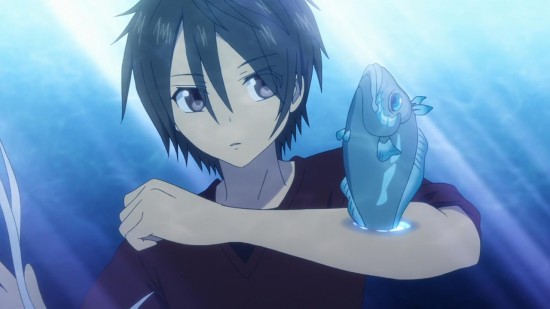
This changes the situation that Uroko faces. If the half-breeds can get ena then it is no longer absolutely necessary for the sea people to remain in hibernation. Their descendents would be able to retreat to the sea. The sea people would be able to survive, even if they didn’t all have blue eyes.
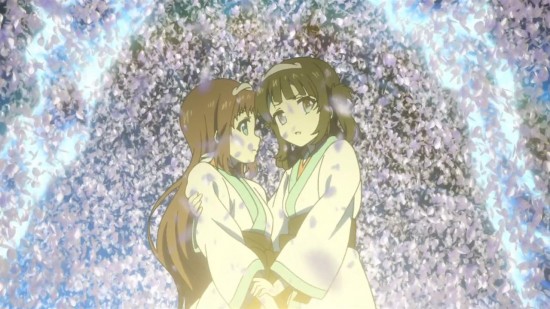
In the second big discovery, Manaka and Miuna make contact with the detritus. From the ancient stored emotions they learn that it was the Sea God whom Ojoshi really loved. Miuna is able to communicate this to the Sea God.
Of course this proves that the Sea God was a tremendous jerk to send Ojoshi away. He wasn’t so much concerned with her happiness as with assuaging his own feelings of guilt. Nevertheless the knowledge gives him some sort of closure and he regains a degree of rationality and self control.
Except for what the Sea God must be feeling, we have a happy ending. The sea people wake up. The sea warms up, though the problem of global cooling has just been delayed, not eliminated. The sea people and land people co-operate and the economy begins to revive. Uroko speculates that with the power of love it may even be possible to save the land.

